| Index - February/March 2017 |
|
Publisher's Message: Don't Tell Mama
by Sue Gillis
|
One of my favorite places in New York City is Don't Tell Mama, named after the song from Cabaret. Located Off Broadway, it's a nightspot for famous and not-so-famous cabaret singers. Even though it's an intimate space, packed mostly with New Yorkers, you can usually get a table. Friendly, noisy, full of surprises and talent, it's a fun night on the town. Don't even think about showing up till 11 p.m. Every town could use a Don't Tell Mama as a refuge from daily unpredictable events, especially now as we wake up and go to bed frightened by the horrors coming out of the White House.
Continue Reading...
|
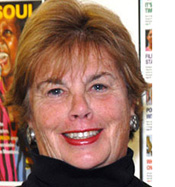
|
|
Mitzi Johnson Carves Out Her Own Agenda as Speaker of the House
by Gail Callahan
|
Mitzi Johnson wears the mantle of a woman for all seasons well.
The Democrat from South Hero is Vermont’s third woman Speaker of the Vermont House, officially securing the position in January. Johnson was unopposed in her bid to become Speaker. At one time, her opponents on the Democratic side included Rep. Sarah Copeland Hanzas (D-Bradford), who dropped her bid to become Speaker, citing Johnson’s strong support from other legislators, and Rep. Chip Conquest (D-Orange-Caledonia). Conquest withdrew from consideration in late fall.
Johnson succeeded Shap Smith of Morristown, a Democrat, who ran in the Democratic primary for lieutenant governor. He was defeated by the now-current lieutenant governor, David Zuckerman.
Johnson’s success in winning the speakership proves she has the support to best other candidates. As Speaker, Johnson is responsible for assigning the 150 representatives to committees and naming the chairs of those panels. The Speaker also sets the House list of priorities during the particular legislative session and schedules meetings that fall among House and Senate leaders and the governor’s office.
Continue Reading...
|
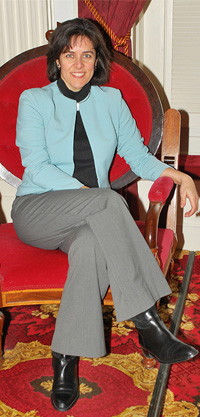
|
|
Jill Krowinski Works Tirelessly for Social Justice
by Kate Mueller
|
Jill Krowinski has been toiling away at the Vermont State House for over a decade, with a bright focus on supporting families and women's rights. Krowinski represents the Old North End (D-Burlington 3-6), where she and her partner, Jim Farbisz, live.
Krowinski grew up in a suburb of Buffalo, New York, and attended the University of Pittsburgh, which she graduated from in 2002 with a major in urban studies and minors in political science and sociology.
For someone who has spent her entire working life engaged in social justice and politics, I wondered if there had been a family influence, as is often the case. But Krowinski didn't grow up in a politically active household. She credits her college internships for shaping her interest in politics: "One internship was with a social justice organization, and my project was to help organize a Rock Against Racism concert. My internship at Carnegie Mellon's Center for Economic Development was also influential through the research I was doing and the conversations I had around the office."
Krowinski originally moved to Springfield, Vermont, to work with 21st Century Democrats at the urging of a friend: "A good friend suggested I work on a political campaign since it was a short time frame and I'd get some great experience grassroots organizing. I had admired Vermont for passing civil unions and—long story short—ended up working on a couple of legislative races in Windsor County."
Continue Reading...
|
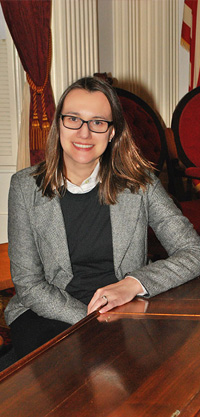
|
|
Becca Balint Leads with Head and Heart
by Susan Z. Ritz |
Senator Becca Balint (D-Windham) brings both a fresh perspective and a courageous heart to her new role as Senate majority leader. As the first openly gay woman elected to the Vermont Senate, Balint, 48, has taken on the challenge of guiding the Democratic Caucus after serving just one term in the legislature.
According to her predecessor, Sen. Phil Baruth (D-Chittenden), she’s a natural for the position. “Becca Balint is one of those rare people who come along every once in a while and electrify the room. I was an early endorser when she ran for the Senate, and I told her constituents that adding her to the ticket would create a dream team. Now that she's here in the State House, they can see I wasn’t exaggerating. After two years, she’s leading our caucus and moving us all forward. In a word, she’s bad-ass, and that’s a proven fact.”
Winning the Senate
Growing up in the Albany, New York, area, Balint knew by age 11 that she wanted to be in politics. “But,” she explained, “it takes a long time to get there if nobody in your family has ever done it. My dad was an immigrant from Hungary (his own father died in the Holocaust), and my mom was working class. Politics was a pipe dream.” It was a dream she kept on the back burner for 30 years. “I was an openly gay woman in the ’80s, and there were no role models for women in politics, so I just put it on a shelf.”
Continue Reading...
|
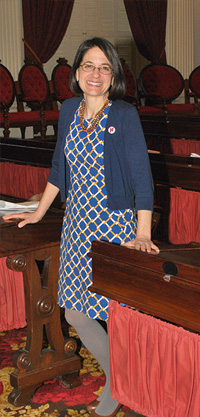
|
|
Thousands Flood into Montpelier for Women’s March
by K.C. Whiteley
|
Like the Women’s March in Washington, DC, Vermont’s solidarity march in Montpelier surpassed all projections. The power of online organizing and the clarion call to justice issues across the spectrum were answered with overwhelming support as an estimated 20,000 Vermonters flooded into the capital city on Saturday, January 21. Leaving cars on the interstate and walking from miles away, carrying homemade signs and banners, Vermonters flocked to the Vermont State House to hear speeches and calls to action.
Vermont Public Radio (VPR) updated its original estimate for the total national turnout for Saturday’s event based on a Washington Post story to 3.7 million in the US alone, possibly the largest demonstration in American history. No arrests were reported, a remarkable testament to the collaborative spirit and peaceful intention of women and their allies who organized the marches and those who showed up.
Intended to be the staging area to start off the march, thousands of people gathered and milled about at the Montpelier High School, lining the sidewalks and spilling onto Bailey Avenue, which had, by 1 p.m., been closed to traffic. Some groups led off the march with banners, followed by a Bread and Puppet–inspired walking float, “We’re All in the Same Boat.”
Continue Reading...
|
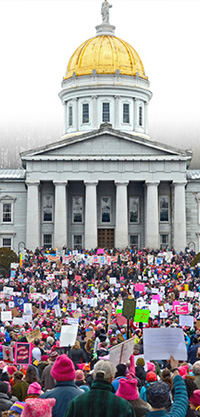
|
|
Taking It to the Streets: Pussies on Parade: The Women’s March in Washington
by Susan Z. Ritz
|
As soon as I heard about the Women’s March in Washington, DC, I knew I had to be there. I had been devastated by Hillary Clinton’s loss to Donald Trump and needed a way to channel my complete despair. Little did I know back then in November, when I booked my ticket on Amtrak, that I was just one of five million people across the globe preparing to march on January 21 to protect the rights and safety of women, the disabled, minorities, the LGBTQA community, and the most marginalized among us.
Genesis of the March
The idea for the march originated when two women, Theresa Shook, a retired attorney and grandmother in Hawaii, and New York fashion designer Bob Bland independently, an ocean and a continent apart, came up with a similar idea for organizing within two days of Trump’s shocking victory. It didn’t take long for thousands of women to sign up through Facebook and other social media sites.
It also didn’t take long for calls to expand the leadership that many saw as too white, too old, and too wealthy to truly represent all American women. While Shook eventually stepped away from the national planning to organize in her home state, Bland recruited three young activists to join her as chairs of the march. Tamika Mallory, an African American gun control activist; Carmen Perez, head of Gathering for Justice and criminal justice reform advocate; and Linda Sansour, a Palestinian American and executive director of the Arab American Association of New York.
Continue Reading...
|

|
Taking It to the Streets: Marchers Swamp Midtown Manhattan
by Kate Mueller
|
The day of the inauguration was, I felt, studiously ignored by New Yorkers. I had traveled to the city two days before to attend the march on Saturday, January 21, and spend sometime visiting friends in a city that is like a second home to me, having lived there during my 20s.
New Yorkers went about their daily lives per usual. If anything, I detected a pall over the city, in keeping with the gray sky that day. On my way to Washington Square Park around noon, with street vendor sandwich in hand, I observed a group of Quakers under the arch with sign unfurled: “Pray for Peace.” They were standing vigil at the exact moment of Trump’s swearing in. While I sat on a park bench eating my sandwich, I overheard two old guys playing chess mutter to each other about “that schmuck” being sworn into the White House. Later, I passed a church in Greenwich Village with a sign out front inviting passersby to enter for prayer and meditation, from noon to three. Not exactly a party atmosphere. Mind you, this is a purely subjective interpretation but one borne out by a New York Times article I read later that documented mostly disinterest or disgruntlement on inauguration day, with a few celebratory pockets, notably on Staten Island, the only borough where Trump won the vote. (But oh yeah, that’s all fake news.)
Continue Reading...
|
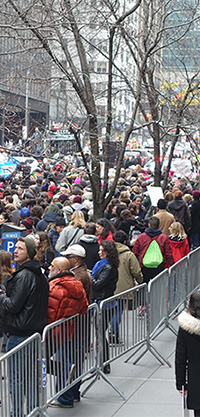
|
|
Listen to Your Mother: Water Is Life: Pipelines, Vermonters & Standing Rock
by K.C. Whiteley
|
“Oceti Sakowin camp embodies the way of life that many of us are aspiring towards. A world in which the first thought is how I can fulfill the needs of others around me, instead of the first thought being how I can take care of my own needs by extracting things from others.” — Michael Moynihan
Over 2.5 million miles of gas and oil pipelines crisscross the U.S. and Canada, like the labyrinth of arteries in our circulatory system, an intricate and interconnected maze. More than half of the nation’s pipelines are at least 50 years old. Inevitably, they will leak and spill.
Plans for the $3.8-billion Dakota Access Pipeline began in 2014, when Bakken oil field production was peaking at about 900,000 barrels of oil a day. Constructed by Energy Transfer Partners (ETP), the pipeline proposes to transport about 470,000 barrels of oil a day, running 1,172 miles from the North Dakota oil fields through South Dakota, Iowa, and Illinois to a terminal in Patoka, Illinois, where the crude oil will be loaded onto railroad cars and connect to an existing pipeline. It crosses hundreds of waterways, disturbs sacred tribal sites and burial grounds, and twice crosses under the Missouri River, which the Lakota people depend on for their water. Another 17 million people downstream also depend on this for their water supply.
Continue Reading...
|
 |
|

